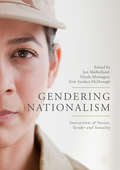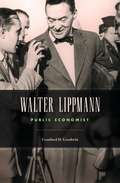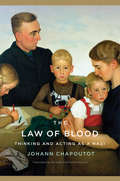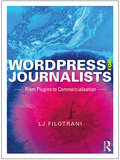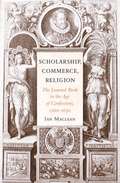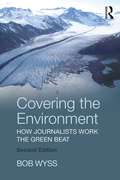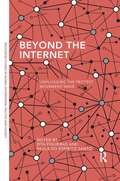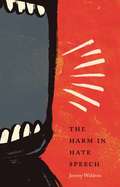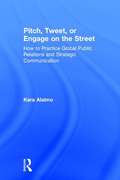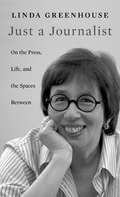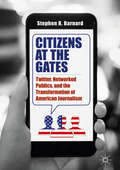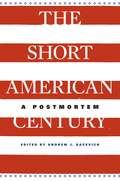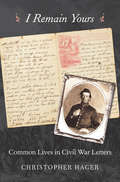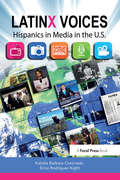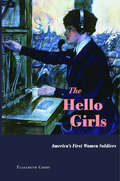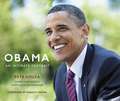- Table View
- List View
Gendering Nationalism: Intersections of Nation, Gender and Sexuality
by Nicola Montagna Jon Mulholland Erin Sanders-McDonaghThis volume offers an empirically rich, theoretically informed study of the shifting intersections of nation/alism, gender and sexuality. Challenging a scholarly legacy that has overly focused on the masculinist character of nationalism, it pays particular attention to the people and issues less commonly considered in the context of nationalist projects, namely women and sexual minorities. Bringing together both established and emerging researchers from across the globe, this multidisciplinary and comparison-rich volume provides a multi-sited exploration of the shifting contours of belonging and Otherness generated by multifarious nationalisms. The diverse, and context specific positionings of men and women, masculinities and femininities, and hegemonic and non-normative sexualities, vis-à-vis nation/alism, are illuminated through a vibrant array of contemporary theoretical lenses. These include historical and feminist institutionalism, post-colonial theory, critical race approaches, transnational and migration theory and semiotics.
Saving the Media: Capitalism, Crowdfunding, And Democracy
by Julia CagéJulia Cagé explains the economics and history of the media crisis and offers a solution: a nonprofit media organization, midway between a foundation and a joint stock company, supported by readers, employees, and innovative financing such as crowdfunding. Her business model is inspired by a central idea: that news, like education, is a public good.
Gandhi’s Printing Press: Experiments In Slow Reading
by Isabel HofmeyrWhen Gandhi as a young lawyer in South Africa began fashioning the tenets of his political philosophy, he was absorbed by a seemingly unrelated enterprise: creating a newspaper, Indian Opinion. In Gandhi’s Printing Press Isabel Hofmeyr provides an account of how this footnote to a career shaped the man who would become the world-changing Mahatma.
Walter Lippmann: Public Economist
by Craufurd D. GoodwinUnemployment, monetary and fiscal policy, and the merits and drawbacks of free markets were a few of the issues the journalist and public philosopher Walter Lippmann explained to the public during the Depression, when professional economists skilled at translating concepts for a lay audience were not yet on the scene, as Craufurd Goodwin shows.
The Law of Blood: Thinking and Acting as a Nazi
by Johann ChapoutotThe scale and the depth of Nazi brutality seem to defy understanding. What could drive people to fight, kill, and destroy with such ruthless ambition? Observers and historians have offered countless explanations since the 1930s. According to Johann Chapoutot, we need to understand better how the Nazis explained it themselves. We need a clearer view, in particular, of how they were steeped in and spread the idea that history gave them no choice: it was either kill or die. Chapoutot, one of France’s leading historians, spent years immersing himself in the texts and images that reflected and shaped the mental world of Nazi ideologues, and that the Nazis disseminated to the German public. The party had no official ur-text of ideology, values, and history. But a clear narrative emerges from the myriad works of intellectuals, apparatchiks, journalists, and movie-makers that Chapoutot explores. The story went like this: In the ancient world, the Nordic-German race lived in harmony with the laws of nature. But since Late Antiquity, corrupt foreign norms and values—Jewish values in particular—had alienated Germany from itself and from all that was natural. The time had come, under the Nazis, to return to the fundamental law of blood. Germany must fight, conquer, and procreate, or perish. History did not concern itself with right and wrong, only brute necessity. A remarkable work of scholarship and insight, The Law of Blood recreates the chilling ideas and outlook that would cost millions their lives.
Wordpress For Journalists: From Plugins To Commercialization
by Laura FilotraniWordPress for Journalists presents an in-depth and accessible introduction to using the content management system WordPress to produce journalism today. LJ Filotrani, an experienced multimedia journalist and website editor and creator, gives readers guidance on using the wide-ranging functionality of WordPress to create news and other forms of journalistic content. Readers will find everything they need to set up both a .com and a .org site, from naming the site and buying a domain to choosing a hosting package and keeping hackers at bay. Chapters also cover house style, how to create posts and pages, hyperlinking, embedding content, setting up widgets and sidebars and working with themes, plugins and SEO. There are sections on troubleshooting, HTML/CSS, RSS and curation, alongside advice on audience engagement and commercialisation. Chapters feature: step-by-step instructions on setting up and managing a professional website, with illustrative images throughout; comprehensive lists of the most useful apps, themes, sites and plugins; a guide to producing multimedia content online, including images, infographics, videos, podcasts and live streaming; expert interviews with professional journalists working successfully online; a glossary of terms. By bringing together real-world advice, detailed walkthroughs and practical tips and tools for best practice, WordPress for Journalists will inspire young journalists and content producers who are looking to widen their skill set and build their presence online.
Wordpress For Journalists: From Plugins To Commercialization (PDF)
by Laura FilotraniWordPress for Journalists presents an in-depth and accessible introduction to using the content management system WordPress to produce journalism today. LJ Filotrani, an experienced multimedia journalist and website editor and creator, gives readers guidance on using the wide-ranging functionality of WordPress to create news and other forms of journalistic content. Readers will find everything they need to set up both a .com and a .org site, from naming the site and buying a domain to choosing a hosting package and keeping hackers at bay. Chapters also cover house style, how to create posts and pages, hyperlinking, embedding content, setting up widgets and sidebars and working with themes, plugins and SEO. There are sections on troubleshooting, HTML/CSS, RSS and curation, alongside advice on audience engagement and commercialisation. Chapters feature: step-by-step instructions on setting up and managing a professional website, with illustrative images throughout; comprehensive lists of the most useful apps, themes, sites and plugins; a guide to producing multimedia content online, including images, infographics, videos, podcasts and live streaming; expert interviews with professional journalists working successfully online; a glossary of terms. By bringing together real-world advice, detailed walkthroughs and practical tips and tools for best practice, WordPress for Journalists will inspire young journalists and content producers who are looking to widen their skill set and build their presence online.
Beyond Winning: Negotiating To Create Value In Deals And Disputes
by Robert H. MnookinConflict is inevitable, in both deals and disputes. Yet when clients call in the lawyers to haggle over who gets how much of the pie, traditional hard-bargaining tactics can lead to ruin. Too often, deals blow up, cases don't settle, relationships fall apart, justice is delayed. Beyond Winning charts a way out of our current crisis of confidence in the legal system. It offers a fresh look at negotiation, aimed at helping lawyers turn disputes into deals, and deals into better deals, through practical, tough-minded problem-solving techniques.
Scholarship, Commerce, Religion: The Learned Book In The Age Of Confessions, 1560-1630
by Ian MacleanThis study of the learned book trade of the late Renaissance reveals how many features of today’s publishing world were in place even then. Beginning in Frankfurt, Maclean surveys the authors, publishers, censors, and sellers who operated in this fraught religious atmosphere and overheated market, and ends with the market’s decline in the 1620s.
Covering the Environment: How Journalists Work the Green Beat
by Bob WyssThis practical primer explains the primary issues in writing about the environment, identifies who to go to and where to find sources, and offers examples of writing and reporting the beat. Observations and story excerpts from experienced journalists provide real-world context both for those in the U.S. as well as internationally. Practice story assignments, resources, and a glossary of critical terms gives budding journalists all the tools needed to cover the green beat. Updated with detailed coverage of how companies and climate change have evolved over the past decade, this second edition expands upon the digital sphere and the myriad ways that deadline, multimedia and mobile reporting have changed environmental journalism. Including consideration of issues such as the water crisis in Flint, Michigan, and the GMO controversy, this new edition provides a fresh take on the green beat with a newly organized table of contents and a guide to freelance and entrepreneurial journalism anywhere in the world. Contents include: • an overview and history of the environment and journalism, spotlighting the most significant issues in the beat; • guidance on understanding environmental and health science, ranging from issues of risk, to scientific research and studies, to interviewing scientists; • insights into government and regulatory communities and environmental advocates on all sides of the political spectrum and internationally; • assistance in accessing public records and conducting digital and computer-assisted reporting; • guidance in writing the story for print, broadcast and internet audiences; • an examination of the future of journalism and news coverage of the environment in the U.S. and throughout the world.
Electromagnetic Waves, Second Edition
by Carlo G. SomedaAdapted from a successful and thoroughly field-tested Italian text, the first edition of Electromagnetic Waves was very well received. Its broad, integrated coverage of electromagnetic waves and their applications forms the cornerstone on which the author based this second edition. Working from Maxwell's equations to applications in optical communications and photonics, Electromagnetic Waves, Second Edition forges a link between basic physics and real-life problems in wave propagation and radiation.Accomplished researcher and educator Carlo G. Someda uses a modern approach to the subject. Unlike other books in the field, it surveys all major areas of electromagnetic waves in a single treatment. The book begins with a detailed treatment of the mathematics of Maxwell's equations. It follows with a discussion of polarization, delves into propagation in various media, devotes four chapters to guided propagation, links the concepts to practical applications, and concludes with radiation, diffraction, coherence, and radiation statistics. This edition features many new and reworked problems, updated references and suggestions for further reading, a completely revised appendix on Bessel functions, and new definitions such as antenna effective height.Illustrating the concepts with examples in every chapter, Electromagnetic Waves, Second Edition is an ideal introduction for those new to the field as well as a convenient reference for seasoned professionals.
Beyond The Internet: Unplugging The Protest Movement Wave (Routledge Studies In Global Information, Politics And Society Series)
by Rita Figueiras Paula Do Espírito SantoThe western economic and financial crisis began with the collapse of Lehman Brothers in 2008 and led the European Union countries into recession. After this, governments started to implement austerity measures, such as cuts in public spending, including public subsidies and jobs, and rising prices. In this context, Europe started to experience a wave of protest movements. Individuals started to use the manifold interactive digital media environment to both fight against the austerity measures and find alternative ways of claiming their democratic rights. Inspired by the 2011 Arab Spring and the Occupy Wall Street movement in New York (USA), the Occupy LSX encampment in Central London (UK), The Outraged (Los Indignados)/ 15M encampment in Central Madrid (Spain), the Syntagma Square’s Outraged movement in Athens (Greece) and the March 12th Movement in Lisbon (Portugal), although short-lived, epitomize an emerging alternative politics and participation via the media. This wave has promoted a debate on how the realm of politics is changing, as citizens broaden their ideas of what political issues and participation mean. Beyond the Internet examines the technological dimension of the recent wave of protest movements in the United Kingdom, Spain, Portugal, Greece, and Ireland. Offering an opportunity to achieve a better understanding of the dynamics between society, politics and technology, this volume questions the essentialist attributes of the Internet that fuel the techno-centric discourse. The contributors illustrate how all these protest movements were active in the social media and garnered high levels of media attention and public visibility, in spite of their failure to achieve their political goals. As intra-elite dissent was pivotal in understanding the Arab uprisings, the coalition of national ruling elites with European institutions in terms of austerity strategy is essential in understanding the limits of media/technology power and, therefore, the dissociation between communication and representative power.
Beyond The Internet: Unplugging The Protest Movement Wave (Routledge Studies In Global Information, Politics And Society Series)
by Rita Figueiras Paula Do Espírito SantoThe western economic and financial crisis began with the collapse of Lehman Brothers in 2008 and led the European Union countries into recession. After this, governments started to implement austerity measures, such as cuts in public spending, including public subsidies and jobs, and rising prices. In this context, Europe started to experience a wave of protest movements. Individuals started to use the manifold interactive digital media environment to both fight against the austerity measures and find alternative ways of claiming their democratic rights. Inspired by the 2011 Arab Spring and the Occupy Wall Street movement in New York (USA), the Occupy LSX encampment in Central London (UK), The Outraged (Los Indignados)/ 15M encampment in Central Madrid (Spain), the Syntagma Square’s Outraged movement in Athens (Greece) and the March 12th Movement in Lisbon (Portugal), although short-lived, epitomize an emerging alternative politics and participation via the media. This wave has promoted a debate on how the realm of politics is changing, as citizens broaden their ideas of what political issues and participation mean. Beyond the Internet examines the technological dimension of the recent wave of protest movements in the United Kingdom, Spain, Portugal, Greece, and Ireland. Offering an opportunity to achieve a better understanding of the dynamics between society, politics and technology, this volume questions the essentialist attributes of the Internet that fuel the techno-centric discourse. The contributors illustrate how all these protest movements were active in the social media and garnered high levels of media attention and public visibility, in spite of their failure to achieve their political goals. As intra-elite dissent was pivotal in understanding the Arab uprisings, the coalition of national ruling elites with European institutions in terms of austerity strategy is essential in understanding the limits of media/technology power and, therefore, the dissociation between communication and representative power.
The Harm in Hate Speech (The Oliver Wendell Holmes Lectures, 2009. #2005)
by Jeremy WaldronFor constitutionalists, regulation of hate speech violates the First Amendment and damages a free society. Waldron rejects this view, and makes the case that hate speech should be regulated as part of a commitment to human dignity and to inclusion and respect for members of vulnerable minorities.
Pitch, Tweet, Engage on the Street: Practicing Global Public Relations and Strategic Communication (PDF)
by Kara AlaimoPitch, Tweet, or Engage on the Street offers a modern guide for how to practice public relations and strategic communication around the globe. Drawing upon interviews with public relations professionals in over 30 countries as well as the author’s own experience as a global public relations practitioner in the United Nations and in U.S. President Barack Obama’s administration, this book explains how to adapt public relations strategies, messages, and tactics for countries and cultures around the globe. The book begins by explaining key cultural differences which require practitioners to adapt their approaches, before discussing how to build and manage a global public relations team and how to practice global public relations on behalf of corporations, non-profit organizations, and governments. Then, the book takes readers on a tour of the world, explaining how to adapt their campaigns for Asia-Pacific, Europe, the Middle East, the Americas, and Sub-Saharan Africa. Along the way, readers are introduced to practitioners around the globe and case studies of particularly successful campaigns – from a public relations "siege" that successfully ended an epidemic of violence in Kenya to the remarkable P.R. strategy adopted by Bordeaux wineries in China that led to a staggering 26,900 percent increase in sales.
Pitch, Tweet, Engage on the Street: Practicing Global Public Relations and Strategic Communication
by Kara AlaimoPitch, Tweet, or Engage on the Street offers a modern guide for how to practice public relations and strategic communication around the globe. Drawing upon interviews with public relations professionals in over 30 countries as well as the author’s own experience as a global public relations practitioner in the United Nations and in U.S. President Barack Obama’s administration, this book explains how to adapt public relations strategies, messages, and tactics for countries and cultures around the globe. The book begins by explaining key cultural differences which require practitioners to adapt their approaches, before discussing how to build and manage a global public relations team and how to practice global public relations on behalf of corporations, non-profit organizations, and governments. Then, the book takes readers on a tour of the world, explaining how to adapt their campaigns for Asia-Pacific, Europe, the Middle East, the Americas, and Sub-Saharan Africa. Along the way, readers are introduced to practitioners around the globe and case studies of particularly successful campaigns – from a public relations "siege" that successfully ended an epidemic of violence in Kenya to the remarkable P.R. strategy adopted by Bordeaux wineries in China that led to a staggering 26,900 percent increase in sales.
The Law of Blood: Thinking and Acting as a Nazi
by Johann ChapoutotThe scale and the depth of Nazi brutality seem to defy understanding. What could drive people to fight, kill, and destroy with such ruthless ambition? Observers and historians have offered countless explanations since the 1930s. According to Johann Chapoutot, we need to understand better how the Nazis explained it themselves. We need a clearer view, in particular, of how they were steeped in and spread the idea that history gave them no choice: it was either kill or die. Chapoutot, one of France’s leading historians, spent years immersing himself in the texts and images that reflected and shaped the mental world of Nazi ideologues, and that the Nazis disseminated to the German public. The party had no official ur-text of ideology, values, and history. But a clear narrative emerges from the myriad works of intellectuals, apparatchiks, journalists, and movie-makers that Chapoutot explores. The story went like this: In the ancient world, the Nordic-German race lived in harmony with the laws of nature. But since Late Antiquity, corrupt foreign norms and values—Jewish values in particular—had alienated Germany from itself and from all that was natural. The time had come, under the Nazis, to return to the fundamental law of blood. Germany must fight, conquer, and procreate, or perish. History did not concern itself with right and wrong, only brute necessity. A remarkable work of scholarship and insight, The Law of Blood recreates the chilling ideas and outlook that would cost millions their lives.
Just a Journalist: On the Press, Life, and the Spaces Between (The William E. Massey Sr. lectures in American studies ; #2015)
by Linda GreenhouseA Pulitzer Prize–winning reporter who covered the Supreme Court for The New York Times, Linda Greenhouse trains an autobiographical lens on a moment of transition in U.S. journalism. Calling herself “an accidental activist,” she raises urgent questions about the role of journalists as citizens and participants in the world around them.
Citizens at the Gates: Twitter, Networked Publics, and the Transformation of American Journalism
by Stephen R. BarnardDrawing insights from nearly a decade of mixed-method research, Stephen R. Barnard analyzes Twitter’s role in the transformation of American journalism. As the work of media professionals grows increasingly hybrid, Twitter has become an essential space where information is shared, reporting methods tested, and power contested. In addition to spelling opportunity for citizen media activism, the normalization of digital communication adds new channels of influence for traditional thought leaders, posing notable challenges for the future of journalism and democracy. In his analyses of Twitter practices around newsworthy events—including the Boston Marathon bombing, protests in Ferguson, Missouri, and the election of Donald Trump—Barnard brings together conceptual and theoretical lenses from multiple academic disciplines, bridging sociology, journalism, communication, media studies, science and technology studies, and political science.
Citizens at the Gates: Twitter, Networked Publics, and the Transformation of American Journalism
by Stephen R. BarnardDrawing insights from nearly a decade of mixed-method research, Stephen R. Barnard analyzes Twitter’s role in the transformation of American journalism. As the work of media professionals grows increasingly hybrid, Twitter has become an essential space where information is shared, reporting methods tested, and power contested. In addition to spelling opportunity for citizen media activism, the normalization of digital communication adds new channels of influence for traditional thought leaders, posing notable challenges for the future of journalism and democracy. In his analyses of Twitter practices around newsworthy events—including the Boston Marathon bombing, protests in Ferguson, Missouri, and the election of Donald Trump—Barnard brings together conceptual and theoretical lenses from multiple academic disciplines, bridging sociology, journalism, communication, media studies, science and technology studies, and political science.
The Short American Century: A Postmortem
by Edited by Andrew J. BacevichIn February 1941, Henry Luce announced the arrival of “The American Century.” But that century—extending from World War II to the recent economic collapse—has now ended, victim of strategic miscalculation, military misadventures, and economic decline. Here some of America’s most distinguished historians place the century in historical perspective.
I Remain Yours: Common Lives in Civil War Letters
by Christopher HagerFor men in the Union and Confederate armies and their families at home, letter writing was the sole means to communicate. Taking pen to paper was a new and daunting task, but Christopher Hager shows how ordinary people made writing their own, and how they in turn transformed the culture of letters into a popular, democratic mode of communication.
LatinX Voices: Hispanics in Media in the U.S
by Katie Coronado Erica KightLatinX Voices is the first undergraduate textbook that includes an overview of Hispanic/LatinX Media in the U.S. and gives readers an understanding of how media in the United States has transformed around this audience. Based on the authors’ professional and research experience, and teaching broadcast media courses in the classroom, this text covers the evolving industry and offers perspective on topics related to Latin-American areas of interest. With professional testimonials from those who have left their mark in print, radio, television, film and new media, this collection of chapters brings together expert voices in Hispanic/LatinX media from across the U.S., and explains the impact of this population on the media industry today.
The Hello Girls: America’s First Women Soldiers
by Elizabeth CobbsIn 1918 the U.S. Army Signal Corps sent 223 women to France to help win World War I. Elizabeth Cobbs reveals the challenges these patriotic young women faced in a war zone where male soldiers resented, wooed, mocked, saluted, and ultimately celebrated them. Back on the home front, they fought the army for veterans’ benefits and medals, and won.
Obama: The Historic Presidency in Photographs
by Pete SouzaThe definitive visual biography of Barack Obama's historic presidency, captured in unprecedented detail by his Chief White House photographer, presented in an oversize, 12"x10"exquisitely produced format, and featuring a foreword from the President himself.Pete Souza was with President Obama during more crucial moments than anyone else and he photographed them all - from the highly classified to the disarmingly candid. Obama: An Intimate Portrait reproduces more than three hundred of Souza's most iconic photographs in exquisite detail, some of which have never been published before. Souza's photographs, with the behind-the-scenes captions and stories that accompany them, document the most consequential hours of the Presidency alongside unguarded moments with the President's family, his encounters with children, interactions with world leaders and cultural figures, and more. These images communicate the pace and power of America's highest office and reveal the spirit of the extraordinary man who became President. The result is a portrait of exceptional intimacy and a stunning record of a landmark era in American history.'Precious historical documents . . . vividly human and often funny . . . these images tell the true story of a presidency that words have failed' Jonathan Jones, Guardian
